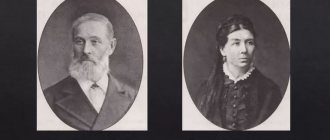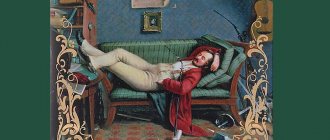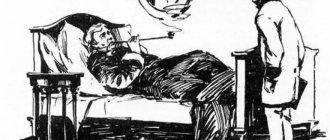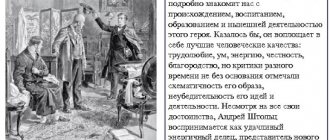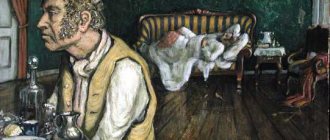Characteristics of creativity by I.A. Goncharova
Ivan Aleksandrovich Goncharov (1812-1891) is an outstanding classic of Russian literature of the second half of the 19th century. Goncharov created his works on the basis of living impressions from provincial life in Simbirsk, studies in Moscow, and public service. Close collaboration with V. G. Belinsky also influenced Goncharov.
Goncharov's early works include the following:
✓ stories “Dashing Sickness”, “Happy Mistake”, “Nymphodora Ivanovna”;
✓ essay “Ivan Savich Podzhabrin”.
The most significant and famous are the following novels by Goncharov:
✓ “Ordinary History” (1846);
✓ “Oblomov” (1849-1859);
✓ “Precipice” (1876).
Goncharov wrote many literary critical articles in which he analyzed the work of both his contemporaries and predecessors. The following critical articles by Goncharov are known:
✓ “A Million Torments” (1872), dedicated to Griboedov’s comedy “Woe from Wit” and including the following thoughts about this comedy:
• liveliness and relevance, as well as individuality and difference from other comedies;
• a true reconstruction of the picture of Moscow morals during the time of Griboyedov;
• transmission of satire, living language, morality;
• vivid depiction of the living types of Famusov, Molchalin, Skalozub;
• analysis of the image and character of the main character - Chatsky: he is positively intelligent (which Pushkin doubted when analyzing this hero); he has a soul, and as a person he surpasses both Pushkin’s Onegin and Lermontov’s Pechorin; is an exponent of a new era, and not an inactive boy and a “superfluous person”; performs the function of a fighter, an exposer of everything old and outdated (unlike Onegin and Pechorin);
✓ “Hamlet Again on the Russian Stage”, which tells about the production of Shakespeare’s plays on the Russian stage;
✓ works devoted to the analysis of the work of A.N. Ostrovsky: “Review of the drama “The Thunderstorm” by Ostrovsky” (1860) and “Materials prepared for a critical article about Ostrovsky” (1874);
✓ “Better late than never” (1879), dedicated to his own novel “The Precipice”, where he broadly comprehended the development of his ideas and images from an early sketch to a late novel and pointed out the connection between all three novels, which lies in the fact that each of the heroes - Pyotr Adulaev, Stolz and Tushin - is an exponent of important trends in social development in Russia;
✓ "Notes on the personality of Belinsky" (1873-1874).
Goncharov’s late artistic works include the following:
✓ “Servants of the Palace Time” (about the life of courtyard people);
✓ “Trip along the Volga”;
✓ essay “Literary Evening” (criticism of anti-democratic creativity and amateurism in literature);
✓ “The month of May in St. Petersburg” (image of his house).
Works of Ivan Goncharov
The beginning of Ivan Alexandrovich’s work dates back to the 1840s. At this time he meets Belinsky. In 1846, Goncharov first read his first novel, “An Ordinary Story,” to Belinsky, and in 1847 the work was published in the Sovremennik magazine.
During the voyage on the frigate “Pallada,” the writer from the first days began to keep detailed notes, which later formed the basis of the work “The Frigate “Pallada,” published in 1858. In literary circles the book was highly appreciated and considered unprecedented.
The next work was published in 1859. It was a novel that became extremely popular - Oblomov. Thanks to him, a new definition appeared - “Oblomovism”. Goncharov worked on the novel for 12 years with a break for travel. This work brought him great success.
After the publication of “Oblomov,” the writer returned to creating the work “The Cliff.” It took Goncharov 20 years to write this novel, although the idea for the book was born back in 1849, when he was in Simbirsk. Ivan Aleksandrovich wanted to convey the atmosphere of the Russian outback, where the patriarchal way of life, which had not yet become obsolete, flourished, but a new way of life had already taken root. While working, the writer often became despondent and several times wanted to leave “The Precipice” unfinished, but still finished it. This work completed the trilogy, reflecting a certain stage in Russian history.
Novel "Ordinary History"
The novel Ordinary History (1846) is Goncharov’s first major work. This novel can be characterized as follows:
✓ the action covers the time period from 1830 to 1843, i.e. about 14 years, which allowed the author to recreate a broad picture of the reality of Russian life in the 30s and 40s;
✓ various layers of society are shown: officials, philistines, bourgeoisie, secular society, village landowners with a patriarchal way of life;
✓ the central conflict is the confrontation between the romantic “youth” and bourgeois morality and the people who profess it, in particular his clash with his own uncle, and in this confrontation, according to the author’s plan, the conflict and breakdown of everything old in Russian society of the second half of the 19th century is expressed. - old concepts about friendship and love, the poetry of idleness, little family lies, etc.;
✓ describes the loss of romantic illusions by the central hero, Alexander Aduev, and this romanticism of the hero is considered by the author as a useless, unnecessary thing that interferes with a useful existence;
✓ shows the “ordinariness”, typicality for that time of the evolution of the protagonist’s nature, which reflects the moods and characters of many young people of that time;
✓ reveals the reasons for the hero’s idleness and empty romanticism, which lie primarily in his environment and upbringing: lordly wealth, unaccustomed to work, security, the readiness of people around him to fulfill all his whims at any moment;
✓ the author debunks the romantic aspirations of his hero.
The artistic originality of the novel “An Ordinary Story” is as follows:
✓ the sequence of conveying the “ordinariness” of the hero’s story - his transformation from an ethereal romantic into a businessman - through the construction of a novel, which has the following features:
• two parts, each of which contains six chapters and an epilogue;
• description in the epilogue of the hero's marriage without love, but with strict calculation;
• comparison of the nephew (the main character) with his uncle, whose traits appear in the main character at the end of the novel;
• implementation of the law of symmetry and contrast;
• a single intrigue in both parts of the novel;
✓ clean, clear and flexible language of presentation, which enhances the value of the work.
The novel “An Ordinary Story” has important social and literary significance, which consists of the following:
✓ strikes at romanticism, provincial dreaminess and bourgeois businessman morality, which does not take into account human qualities and the soul;
✓ denotes the leading trends and rules of life of the author’s contemporary society;
✓ draws a portrait of a typical young man of that time - a “hero of the time”;
✓ shows true pictures of the reality of that time;
✓ affirms the principle of realism in representing reality;
✓ demonstrates the author’s main principle - a realistic, objective attitude towards his hero;
✓ contributes to the development of the genre of socio-psychological novel;
✓ topical in its content and raises one of the most important questions of human existence: how and why one should live.
Biography of the writer
Ivan Aleksandrovich Goncharov (1812–1891), Russian writer of the 19th century, was born into a wealthy merchant family. In addition to him, there were three more children in the Goncharov family. After the death of the father, the mother and their godfather N.N. took up raising the children. Tregubov, an educated man of progressive views, familiar with many Decembrists. During his years of study at a private boarding school, Goncharov began reading books by Western European and Russian authors and learned French and Russian well. In 1822, he successfully passed the exams at the Moscow Commercial School, but without graduating, he entered the philological department of Moscow University.
During his years at the university, Goncharov turned to literary creativity. Of the subjects he studied, he was most attracted to the theory and history of literature, fine arts, and architecture. After graduating from the university, Ivan Aleksandrovich entered the service in the office of the Simbirsk governor, then moved to St. Petersburg and took the position of translator in the Ministry of Finance. However, his service did not prevent him from pursuing literature and maintaining friendly relations with poets, writers and painters.
Goncharov’s first creative experiments - poetry, then the anti-romantic story “Dashing Illness” and the story “Happy Mistake” - were published in a handwritten journal. In 1842, he wrote the essay “Ivan Savich Podzhabrin”, published only six years after its creation. In 1847, the Sovremennik magazine published the novel Ordinary History, which evoked enthusiastic criticism and brought great success to the author. The novel is based on the collision of two central characters - Aduev the uncle and Aduev the nephew, personifying sober practicality and enthusiastic idealism. Each of the characters is psychologically close to the writer and represents different projections of his spiritual world.
The pinnacle of the writer’s creativity was the novel “Oblomov,” the creation of which Goncharov began back in the 40s. Before the novel was published, “Oblomov’s Dream”, an excerpt from the future work, appeared in the almanac “Literary Collection with Illustrations”. “Oblomov’s Dream” was highly praised by critics, but ideological differences were evident in their judgments. Some believed that the passage had great artistic value, but rejected the author's irony in relation to the patriarchal landowner way of life. Others recognized the writer’s undoubted skill in describing scenes of estate life and saw in the excerpt from Goncharov’s future novel a creative step forward compared to his previous works.
In 1852, Goncharov, as secretary to Admiral E.V. Putyatina set off on a circumnavigation of the world on the frigate Pallada. Simultaneously with the performance of his official duties, Ivan Alexandrovich collected material for his new works. The result of this work was travel notes, which in 1855–57. were published in periodicals, and in 1858 they were published as a separate two-volume publication entitled “Frigate “Pallada””. The travel notes convey the author's impressions of getting to know the British and Japanese cultures, reflecting the author's opinion about what he saw and experienced during the trip. The paintings created by the author contain unusual associations and comparisons with the life of Russia and are filled with a lyrical feeling. Travel stories were very popular among Russian readers.
Returning from his trip, Goncharov entered the service of the St. Petersburg Censorship Committee and accepted an invitation to teach Russian literature to the heir to the throne. From that time on, the writer’s relations with Belinsky’s circle cooled noticeably. Acting as a censor, Goncharov assisted in the publication of a number of the best works of Russian literature: “Notes of a Hunter” by I.S. Turgenev, “A Thousand Souls” by A.F. Pisemsky and others. From the autumn of 1862 to the summer of 1863, Goncharov edited the newspaper “Northern Post”. Around the same time, his withdrawal from the literary world began. The ideal writer, by his own admission, consisted of “a piece of independent bread, a pen and a close circle of his closest friends.”
In 1859, the novel “Oblomov” was published, the idea of which was formed back in 1847. From the moment the chapter “Oblomov’s Dream” was published, the reader had to wait almost ten years for the appearance of the full text of the work, which immediately won enormous success. The novel caused heated debate among readers and critics, which testified to the depth of the author's intention. Immediately after the novel was published, Dobrolyubov wrote an article “What is Oblomovism?”, which was a merciless trial of the main character, a “completely inert” and “apathetic” master, who became a symbol of the inertia of feudal Russia. Some critics, on the contrary, saw in the main character an “independent and pure”, “tender and loving nature”, who consciously distanced herself from fashionable trends and remained faithful to the true values of existence. Disputes about the main character of the novel continued until the beginning of the 20th century.
Goncharov’s last novel, “The Cliff,” published in 1869, presents a new version of Oblomovism in the image of the main character, Boris Raisky. This work was conceived back in 1849 as a novel about the complex relationship between the artist and society. However, by the time he began writing, the writer had somewhat changed his plan, which was dictated by new social problems. At the center of the novel was the tragic fate of revolutionary-minded youth, represented in the image of the “nihilist” Mark Volokhov. The novel "The Precipice" received mixed reviews from critics. Many questioned the author's talent and denied him the right to judge modern youth.
Education and career
At the initial stage, Ivan Goncharov’s education was handled by his godfather, and later the boy was sent to a private boarding school. When Goncharov was ten years old, he was sent to the Moscow Commercial School, where he studied for eight years.
In 1831, the future writer became a student at the Faculty of Literature at Moscow University. After completing his studies at the university in 1834, Ivan Alexandrovich left for his native Simbirsk and accepted the position of secretary to the governor, but a year later returned to Moscow.
In Moscow, Goncharov enters the service of the Foreign Trade Department of the Ministry of Finance as a translator. At the same time, he gets a job in the house of the artist Maykov, as a tutor for Apollo.
